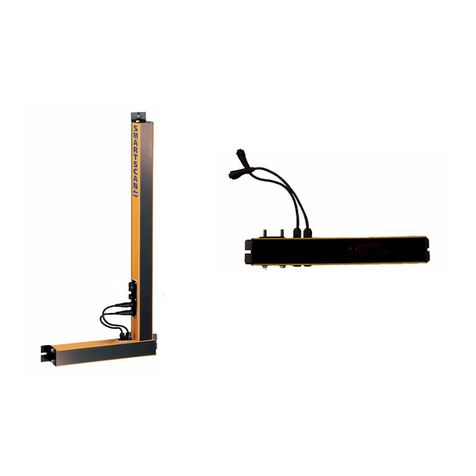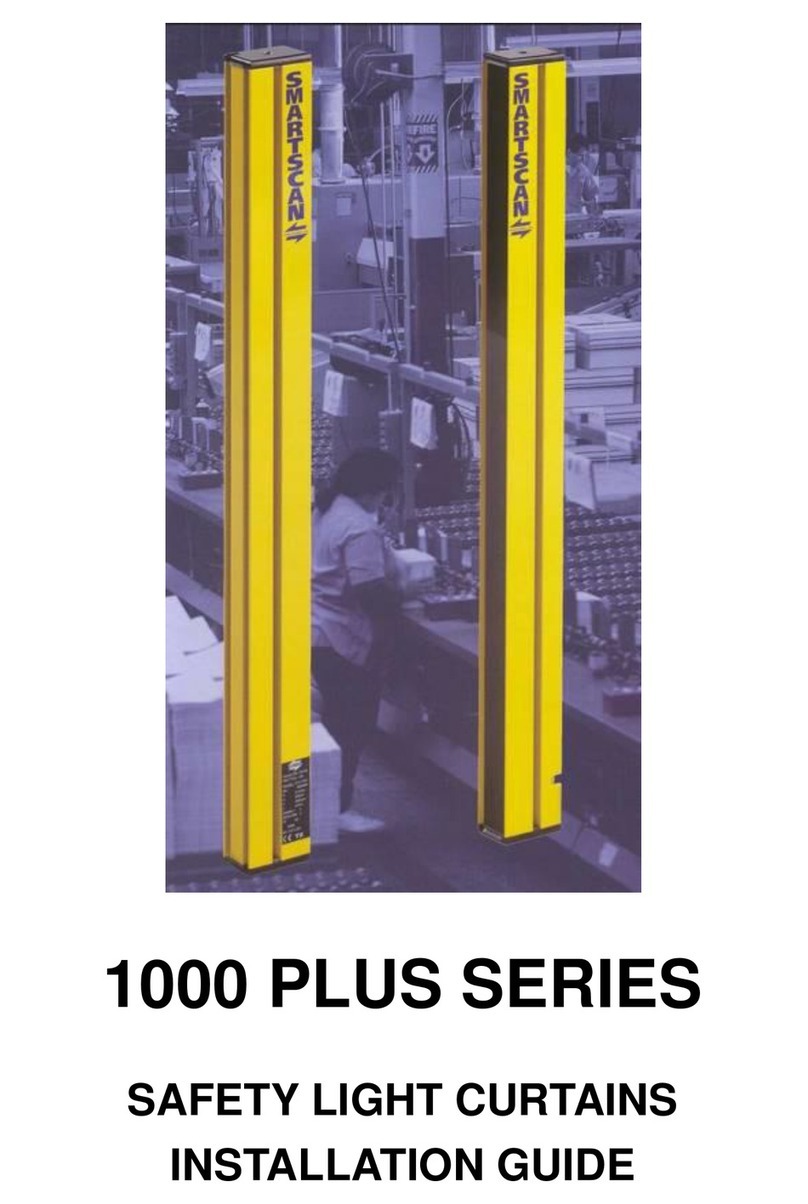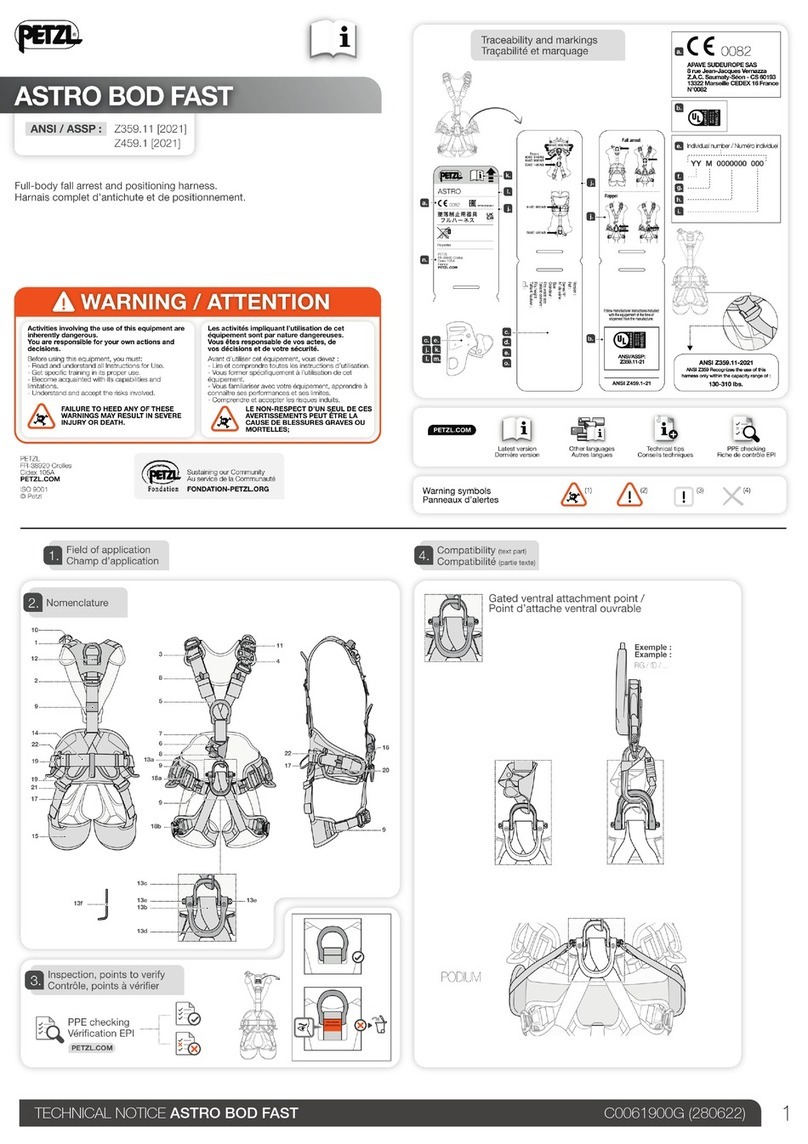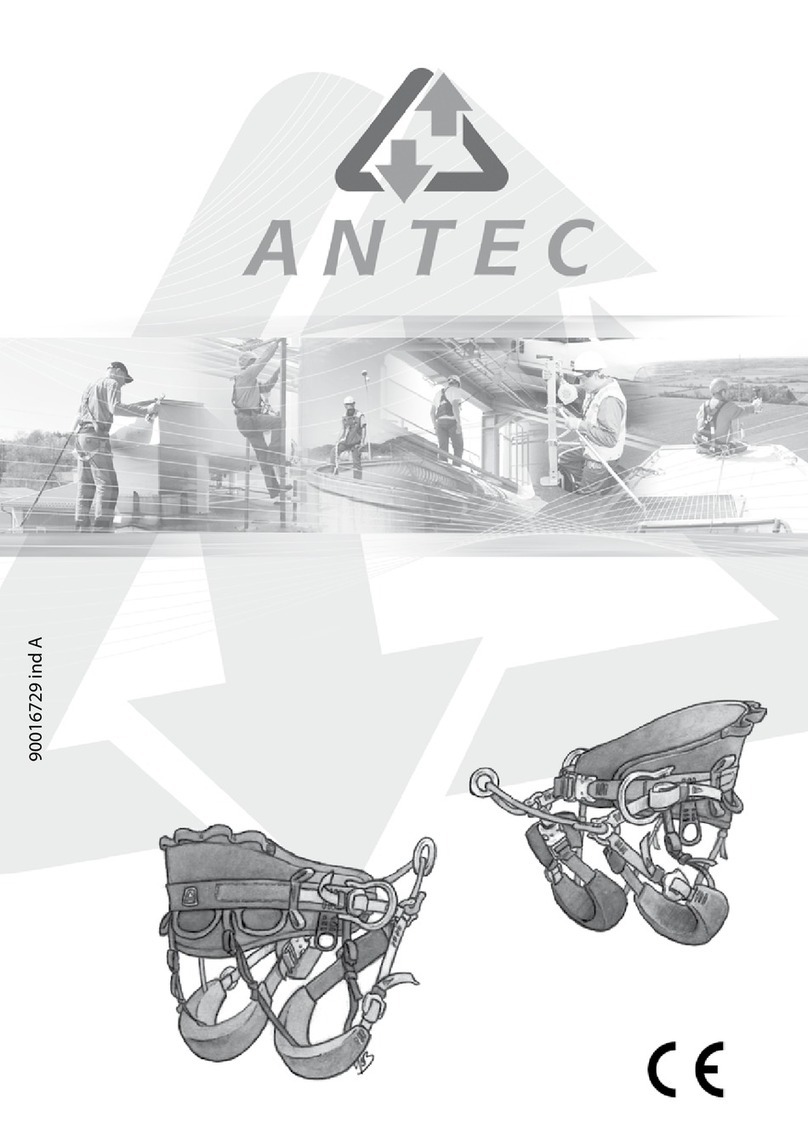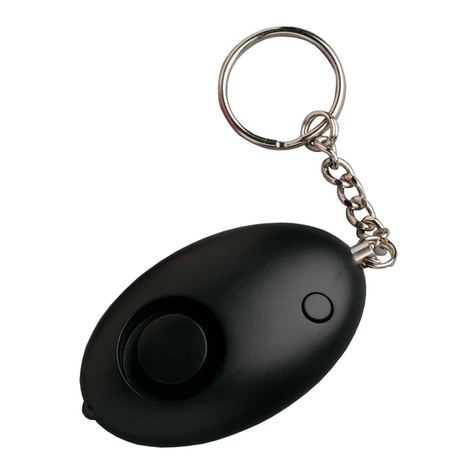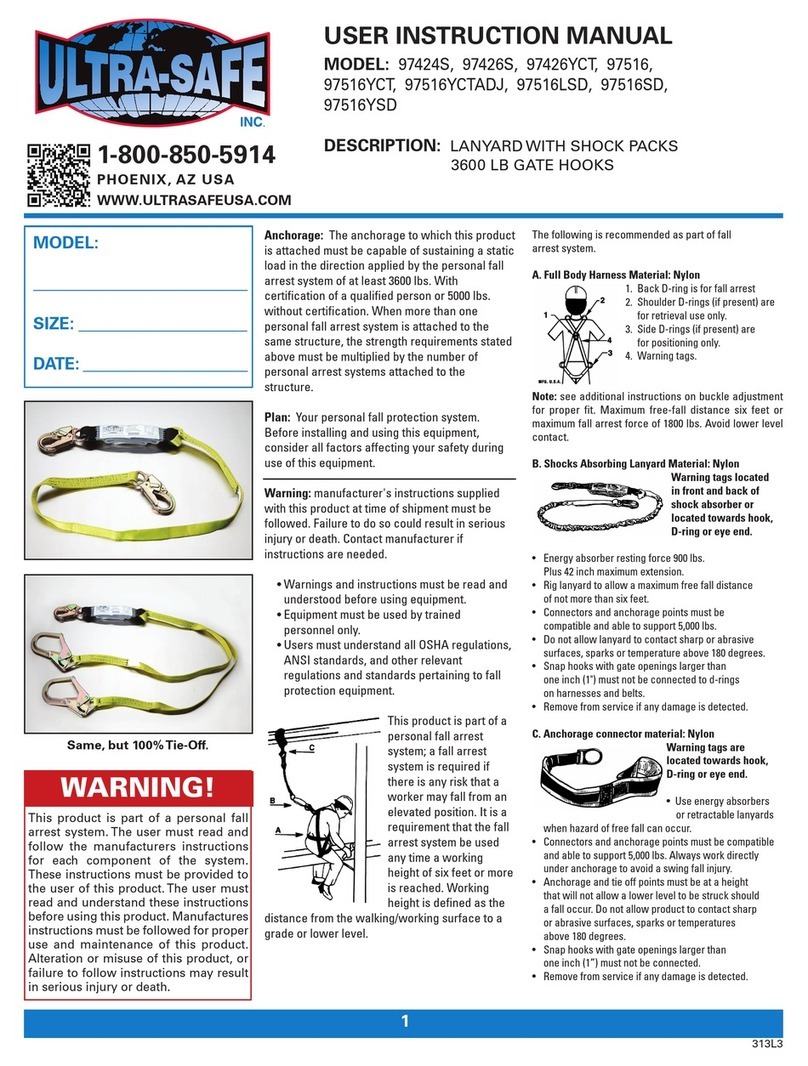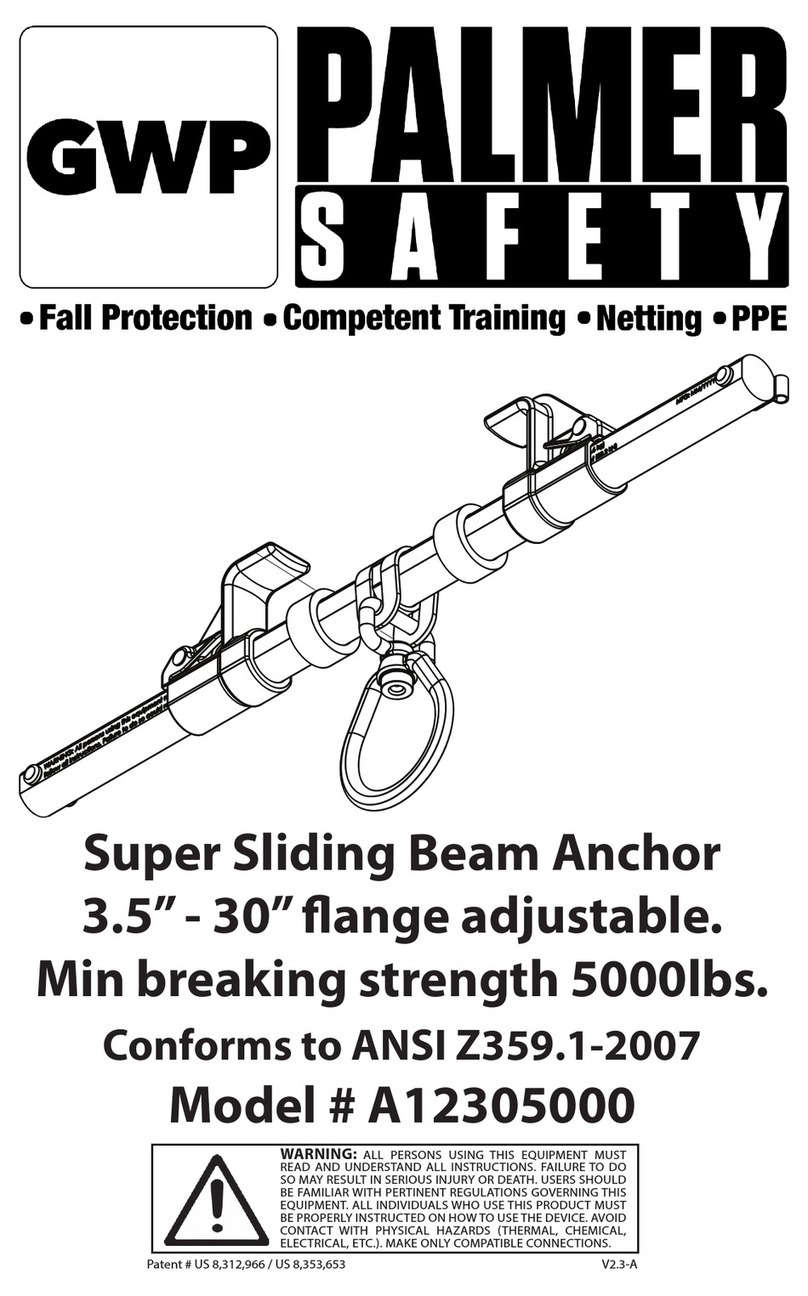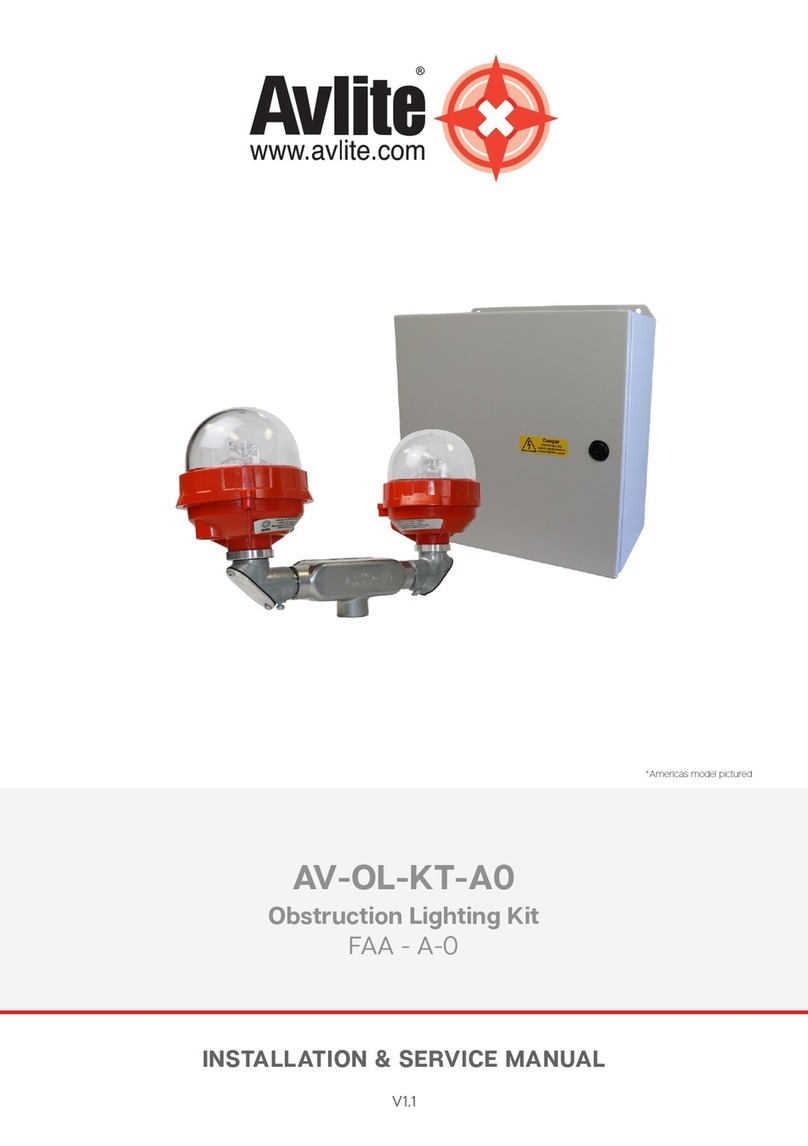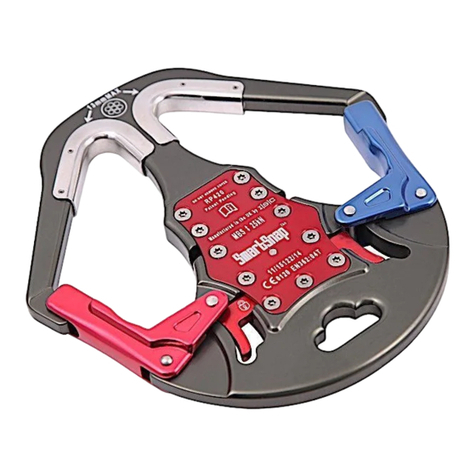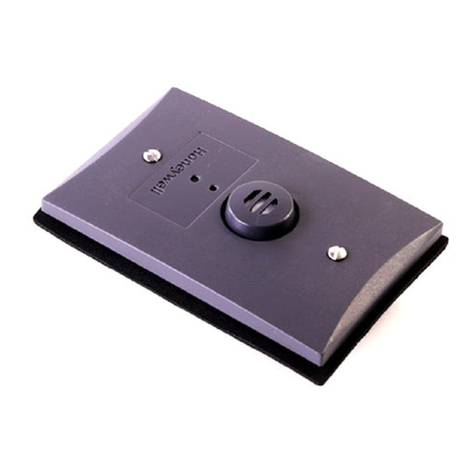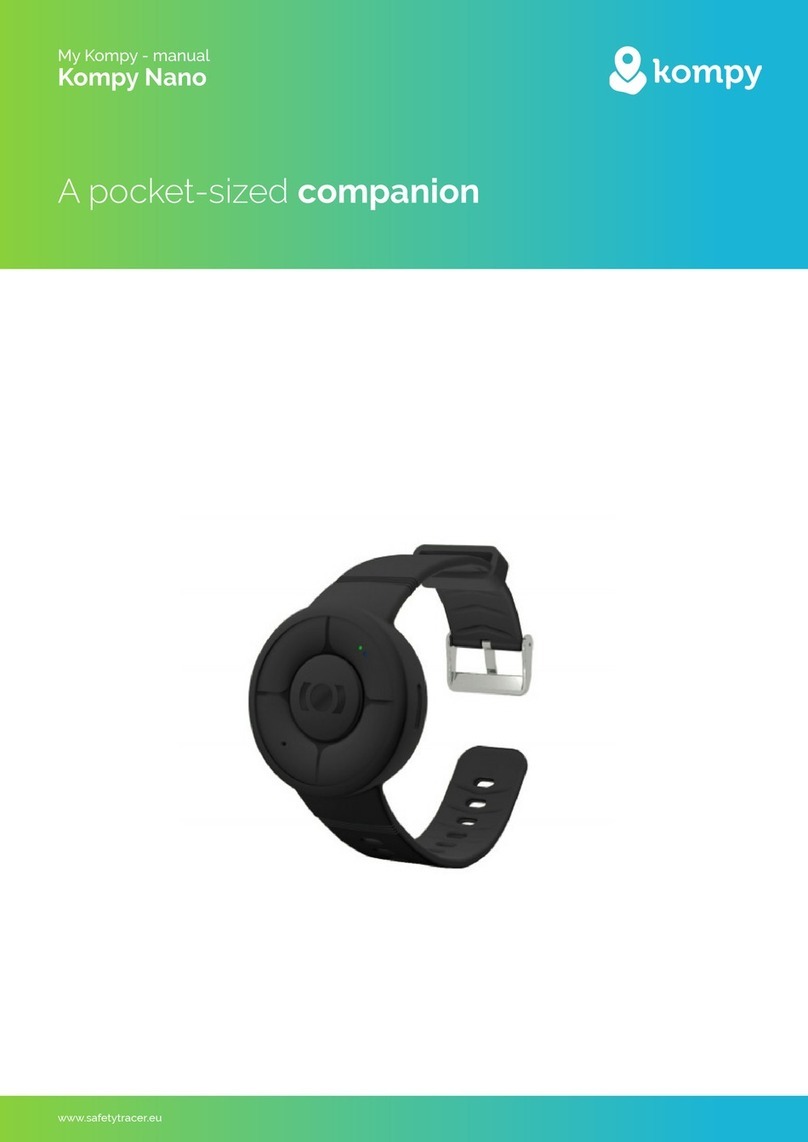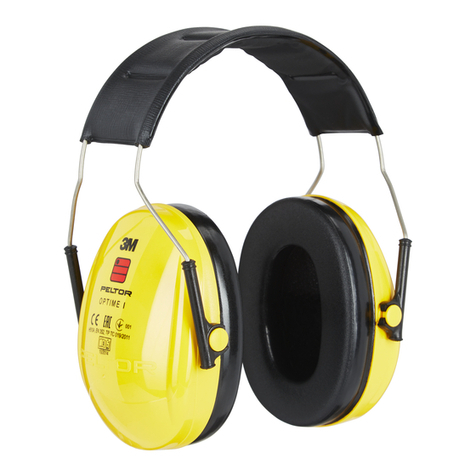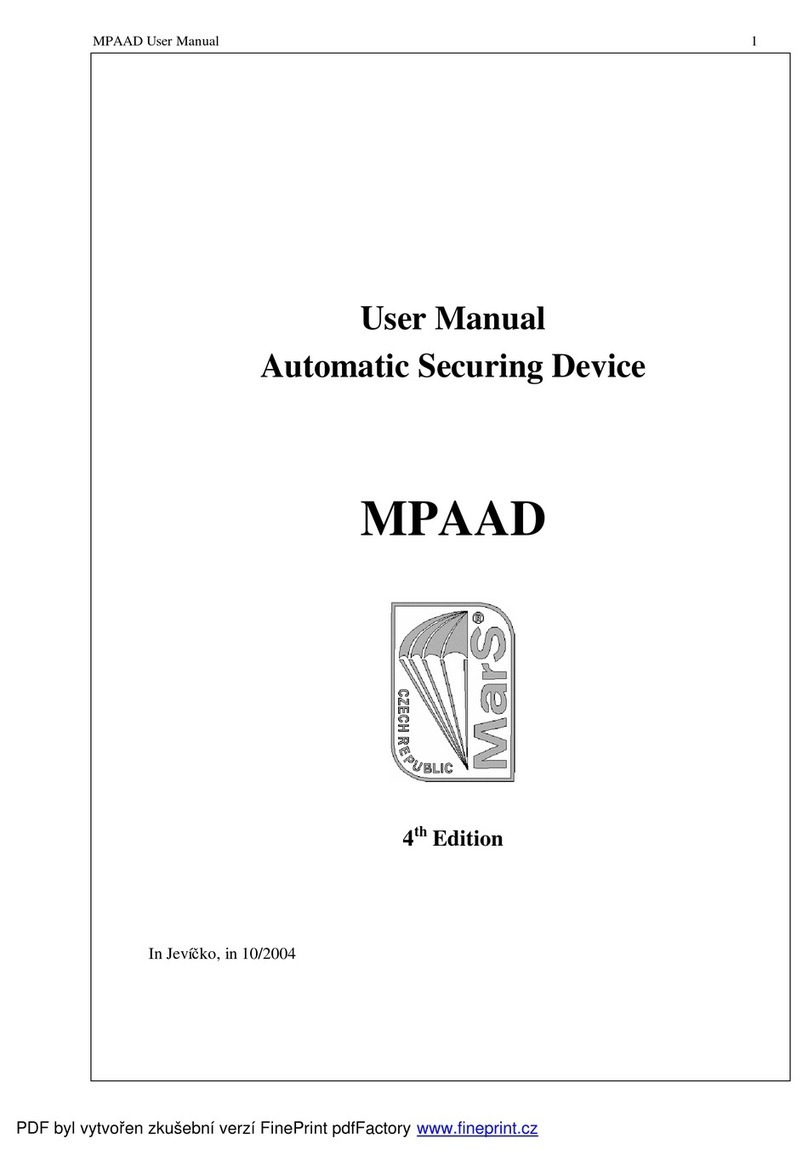SMART-SCAN T4 Series User manual

T4 (053B) SERIES
SAFETY LIGHT CURTAINS
INSTALLATION GUIDE
MACHINERY SAFETY SYSTEMS

Smartscan Ltd
Pywell Road
Willowbrook Industrial Estate
Corby
Northamptonshire
NN17 5XJ - England
Tel. +44 (0)1536 –401 313
www.smartscan.co.uk
Important!
Failure to read and follow the instructions provided on the Installation Sheet
and Installation Guide can lead to the incorrect application or use of the T4
(053B) series safety light curtain. This could lead to personal injury and
damage to equipment. All applicable machine safety standards and
regulations should be taken into account when installing the T4 (053B) series
safety light curtain or any machine safety product.
The Installation Sheet and Installation Guide can be downloaded from our web
site at www.smartscan.co.uk
The T4 (053B) series Safety Light Curtain Installation Guide (CD354/220116)
is subject to change without notice. Smartscan Ltd shall not be held
responsible for technical errors, editorial errors or omissions contained herein,
nor for incidental or consequential damages resulting from the use of this
material.
© 2016 Smartscan Ltd. All Rights Reserved. Unless explicitly stated
otherwise, all rights including those in copyright in the content of this document
are owned by or controlled for these purposes by Smartscan Ltd.
Except as otherwise expressly permitted under copyright law or Smartscan
Ltd, reproduction of the document or alteration of this document may not be
carried out in any way without first obtaining Smartscan Ltd.’s written
permission.

CONTENTS
FIGURE A - UNPACKING..........................................................................................1
FIGURE B –CABLE CONDUCTORS ........................................................................2
FIGURE C –OPERATING REQUIREMENTS ............................................................3
STATUS INDICATORS.................................................................................................5
FIGURE D –IMPORTANT INSTALLATION CONSIDERATIONS..............................6
FIGURE E - ELECTRICAL CONNECTIONS ..............................................................8
POWER SUPPLY .......................................................................................................9
RESET ...................................................................................................................10
EXTERNAL DEVICE MONITORING (EDM) ..................................................................10
SAFETY OUTPUTS OSSD1 AND OSSD2..................................................................11
MUTE FUNCTION.....................................................................................................11
MUTE OUTPUT........................................................................................................12
STATUS OUTPUT ....................................................................................................12
COMMUNICATION LINK............................................................................................12
FIGURE F –MUTING TIMERS.................................................................................13
MUTE INPUT DISPARITY TIME (A).............................................................................13
MUTE TIME OUT PERIOD (B)....................................................................................14
MUTE DELAY OFF TIME (C).....................................................................................14
FIGURE G –MECHANICAL INFORMATION...........................................................15
FIGURE H –FLOATING BLANKING.......................................................................17
FIGURE I –IDENTIFICATION LABELS...................................................................17
FIGURE J –DIP SWITCH SETTINGS AND OPERATING MODES .........................18
DIRECT SETTINGS...................................................................................................19
1) Floating Beam Blanking..........................................................................20
2) Mute Time Out Period..............................................................................22
3) Modes.......................................................................................................23
4) Parity (ODD).............................................................................................24
LEARN SETTINGS....................................................................................................25
Learn Setting 0 - Fixed Beam Blanking .........................................................25
Learn Setting 2 - Mute Timer (Mode 2)...........................................................27
Learn Setting 3 - Mute Timer (Mode 3)...........................................................28
Learn Setting 4 - Mute Timer (Mode 4)...........................................................28
Learn Setting 5 - Partial or Learn Fixed Muting.............................................29
Learn Setting 7 - Clear All Learnt...................................................................30
FIGURE K –TEST AND MAINTENANCE................................................................31
TESTING THE SAFETY LIGHT CURTAIN WITH THE TEST PIECE ......................................31
MAINTENANCE........................................................................................................32
FIGURE L –OPERATION CYCLE...........................................................................33
FIGURE M –PRODUCT RETURN PROCEDURE....................................................34
FIGURE N –MODEL LIST .......................................................................................35
FIGURE O –DECLARATION OF CONFORMITY....................................................36
FIGURE P –GLOSSARY OF WORDS AND LANGUAGE TRANSLATION.............37

APPENDIX 1 –IMPORTANT SAFETY INFORMATION...........................................38
APPENDIX 2 - CERTIFICATIONS............................................................................39
APPENDIX 3 - MIRRORS.........................................................................................40
APPENDIX 4 –SPECIFICATION TABLE.................................................................44
NOTES .....................................................................................................................45

T4 (053B) Series Installation Guide
CD354/220116 Smartscan Ltd
1
T4 Series (Model No. 053B-xxxx) Safety Light Curtain
Installation Sheet (CD240/190116)
Figure A - Unpacking
Remove all packaging material and retain it
Locate and keep the delivery note
Inspect all items for transit damage
Match goods supplied to those specified on the delivery note
Keep the Installation Sheet in a safe place
Each T4 (053B) series supplied would normally include:
Safety Light curtain
Test piece (excluding 053B-6xx)
Installation sheet
Service questionnaire form
Storage requirements:
Humidity - <95%
Temperature range between –20°C and +70°C

T4 (053B) Series Installation Guide
CD354/220116 Smartscan Ltd
2
T4 (053B) series (LUM)
cable showing M12
connector
Figure B –Cable Conductors
The picture above shows the M12 connector pin
out, the colour coding for the cable cores, the
signal function for the corresponding cable core,
and the current rating for input/output signals.
The standard cable supplied will use the LUM
colour code shown above.
The T4 (053B) series safety light curtain requires a connection cable on the
Transmitter (TX) head and a connection cable on the Receiver (RX) head. They
are connected via the M12 (8 way) socket located on the bottom end cap. The
M12 socket also forms a locator for the mounting bracket.

T4 (053B) Series Installation Guide
CD354/220116 Smartscan Ltd
3
Figure C –Operating Requirements

T4 (053B) Series Installation Guide
CD354/220116 Smartscan Ltd
4
Humidity <95%
Temperature range between -30°C and +50°C
Vibration: Frequency <55Hz Max. Movement <0.35mm
Do not use equipment in explosive atmospheres (contact the manufacturer for
further advice).
Noise generated by the equipment will never exceed 70 dB
Heaters
The T4 (053B) series includes a heater system as standard. The heaters are
activated when the temperature drops below 0°C and automatically switch off
when the temperature rises above it again.
Detection Zone width (DZ) (K)
The detection zone width or protected height must be of a suitable size for each
application to prevent personnel access to the danger area. This can be over,
under or around the light curtains detection zone.
Object Detection Capability (ODC) (N)
The minimum size of object guaranteed to be detected when placed in the light
curtain’s infrared sensing field. A test piece of appropriate size is provided to test
that the light curtain object detection capability is within the parameter specified
for the particular model number. Transparent objects are not detected.
Range (R)
This is the maximum scanning range of the light curtain between the Transmitter
(TX) head and Receiver (RX) head. Ensure the light curtain is capable of
satisfying the range requirement for the particular application it is being used for.
Reset Location
Reset devices must be located such that the danger area can be seen to be clear
of persons before the system is activated. The reset device should not be
accessible from inside the danger area.

T4 (053B) Series Installation Guide
CD354/220116 Smartscan Ltd
5
Status Indicators
LEDs for status indication and diagnostics are located in the top of the Transmitter
(TX) head and Receiver (RX) head. In addition the Receiver (RX) head has six
LEDs at the bottom located inside the housing to aid DIP switch setting. To aid
configuration each DIP switch has a corresponding colour LED to acknowledge
activation of the individual DIP switch.
Receiver (RX) Top
ON –GREEN LED on = OSSDs in the on state
OFF –RED LED on = OSSDs in the off state
LO1 (Lockout 1) –YELLOW LED on = OSSD fault
LO2 (Lockout 2) –YELLOW LED on = Mute disparity fault (MU1 & MU2)
EDM (External Device Monitoring) –YELLOW LED on = EDM on
Receiver (RX) Bottom
LEDs located on the DIP switch board are accessed via a cap on the side of the
extrusion. (Ensure that the cap is securely in place to maintain IP integrity after
use).They are used to show the status of each individual DIP switch. LED on
equals DIP switch in the ‘ON’ position, LED off equals DIP switch in the ‘OFF’
position.
DIP switch 1 = Red LED
DIP switch 2 = Yellow LED
DIP switch 3 = Green LED
DIP switch 4 = Blue LED
DIP switch 5 = Red LED
DIP switch 6 = Orange LED
Transmitter (TX) Top
PWR (Power) - RED LED on = Power connected
STAT (Status) - GREEN LED on = Alignment ok
MUT (Muted) –YELLOW LED on = Muted
MU1 (Mute1) –BLUE LED on = Mute 1 on
MU2 (Mute2) –BLUE LED on = Mute 2 on

T4 (053B) Series Installation Guide
CD354/220116 Smartscan Ltd
6
Figure D –Important Installation Considerations
1. Consider reflective
surfaces that may
give rise to an optical
‘short circuit’ from the
direct path of the
safety light curtain’s
infrared beams as
shown in the first
illustration of Fig. E.
To ensure the safety
light curtain is
mounted far enough
away from reflective
surfaces use the
formula provided to
calculate the
minimum distance
(X) between the light
curtain and reflective
surface.
2. To prevent
intermittent tripping of
the safety light
curtain ensure that
extraneous infrared
energy between 800
and 1000
nanometres is not
directed towards the
Perspex window of
the receiver unit
(RX). Extraneous
sources would
include infrared
sensors, infrared remote controls, scanning systems or sunlight.
3. Ensure the mounting position of the safety light curtain in respect to the
nearest danger point meets the requirements of European Standard ISO
13855. The Separation distance of the safety light curtain from the danger
point of the machine must be met at all times for safe operation. In order for
the machine to be guarded by the safety light curtain, the machine must be
capable of stopping at any point in the machine cycle.
To prevent personnel from reaching the danger point of the machine additional
mechanical guarding may be required so that any access has to be through
the sensing field of the safety light curtain. The safety light curtain must be

T4 (053B) Series Installation Guide
CD354/220116 Smartscan Ltd
7
positioned so as to prevent any overreach or under reach to the danger point.
It must not be possible to stand between the safety light curtain and the
danger point.
The protection afforded by the safety light curtain should correspond to the
machine Risk Assessment under EN ISO 12100 for the machine being
guarded.
4. Ensure the light curtain transmitter (TX) and receiver (RX) units are mounted
accurately in-line with each other and are both perpendicular and parallel to
each other within the parameters shown for each axis.
5. If utilising mirrors to deflect the light curtain ensure the mirror length is 50mm
longer at either end of the light curtain detection zone width and mounted
centrally to the zone. To ensure reliable operation the light curtain deflection
angle (A) from the mirror must not be less than 40 degrees or greater than 100
degrees. (See Appendix 3)
Environmental factors can affect the operation of a safety light curtain and proper
consideration should be taken into account for mounting a system where fog, rain,
smoke, dust, large temperature fluctuations etc. is a consideration.
Safety light curtains do not protect personnel from chemicals, heat, gases,
radiation, flying parts etc. They are not a physical barrier.
The machine operators must be instructed in the use of the safety light curtain by
the owner/provider of the machinery.

T4 (053B) Series Installation Guide
CD354/220116 Smartscan Ltd
8
Figure E - Electrical Connections

T4 (053B) Series Installation Guide
CD354/220116 Smartscan Ltd
9
Power Supply
Use a regulated power supply +24V DC ±10% fused at 2A. The T4 (053B) series
light curtain current consumption is rated at 1.5A. The White wire on both the
Transmitter (TX) and Receiver (RX) head cables must be connected to 24V DC
(L+). The Brown wire on both the Transmitter (TX) and Receiver (RX) head
cables must be connected to 0V DC (L-).
Before the power supply is applied to the light curtain ensure both TX and RX
heads are aligned correctly. On power up the PWR LED on the Transmitter (TX)
head will turn on to indicate power is connected.
If during set-up LED LO1 and LO2 start to flash alternately this is due to the
Transmitter (TX) head cable not being connected.
If the Power LED starts to flash during set-up the Receiver (RX) head cable is not
connected.
Warning Do not disconnect the cables from the Transmitter (TX) or
Receiver (RX) head with the power still connected to the T4 (053B)
series light curtain.
Any wiring or re-wiring of the light curtain must be done with the power
supply disconnected.
Any input or output signals that are not being used must be terminated
to an individual isolated terminal block.
The machine must be disconnected during electrical installation to
ensure no inadvertent start-up of the machine occurs.
The connection cables must not be routed with high-voltage cables,
e.g. inverter cables or motor power supplies.
Warning 0V (L-) of the power supply unit (PSU) must be connected
to ground. No signal should exceed +24V DC ±10% (L+) or be less than
0V (L-)
Warning The shield on both the Transmitter (TX) and Receiver (RX)
head cables must be connected to Earth (PE).
PWR - Red LED ON = Power connected

T4 (053B) Series Installation Guide
CD354/220116 Smartscan Ltd
10
Reset
The T4 (053B) series provides a manual (latched) reset for applications where it is
a requirement that the safety outputs cannot be reinstated without the operator
first checking that the dangerous area is clear of personnel and therefore safe.
The reset switch must also be located so that the operator cannot reset the safety
light curtain from inside the danger area.
The reset switch must be a Normally Open spring-return contact block, either
push button or key switch depending on the application risk assessment. The
Green wire on the Receiver (RX) head cable needs to be connected to one side of
the Normally Open contact block and the other side to 24V DC (L+). The safety
light curtain will only reset on the trailing edge of the switch.
However for the Automatic reset function the Green wire is no longer required and
must be terminated to an individual isolated terminal block.
The Automatic and Restart Interlock options are selected via DIP switches, refer
to the DIP switch setting guide later in this manual.
External Device Monitoring (EDM)
An External Device Monitoring input facility is provided for monitoring the
customers’ external Final Switching Devices (FSD) to ensure those devices
respond in unison with the safety outputs each and every time the light curtain is
interrupted. Failure of the external Final Switching Device (FSD) during
monitoring will not allow the safety light curtain’s output OSSDs to reset.
The EDM Yellow wire on the Receiver (RX) head should be connected via a
normally closed (NC) contact of the external final switching device being
monitored. The other side of the contact is connected to 24V DC.
If the EDM is not being used the Yellow wire must be connected to a permanent
24V DC (L+).
A LED indicator located at the top of the Receiver (RX) head labelled as EDM
shows the EDM status.
Yellow LED ON = EDM ON Yellow LED OFF = EDM OFF
Note: Prior to initial power up of the light curtain check the following.
If the Smartscan system is connected directly to a 24V DC source
supplied by the user, it must be emphasised that the supply should be
regulated and suppressed to prevent transient voltages and other forms
of electrical interference from affecting correct operation of the Smartscan
equipment. Ensure the 24V DC source supplied by the user has
sufficient current load to satisfy the safety light curtain current
consumption requirement, taking into account any other devices already
connected to the PSU.

T4 (053B) Series Installation Guide
CD354/220116 Smartscan Ltd
11
Safety Outputs OSSD1 and OSSD2
Two independent (PNP) electronic switching failsafe signal outputs (OSSDs) are
provided for connection to the machine’s stop control circuit. Interruption of the
safety light curtains infrared sensing field (unless muted or blanked) will cause the
OSSDs to go to an OFF state and initiate a machine stop condition. The
connections are provided via the Grey wire (OSSD1) and the Pink wire (OSSD2)
on the Receiver (RX) head cable.
Outputs ON = +24V DC (Light curtain clear)
Outputs OFF = 0V DC (Light curtain blocked)
The electronic outputs are monitored and rated at a maximum switching rating of
24V DC, 500mA.
LED indicators located at the top of the Receiver (RX) head labelled as ON and
OFF show the status of the OSSDs.
If the LO1 LED on the RX head turns on it shows that the light curtain safety
outputs (OSSDs) have gone to a fault condition. This means that the light curtain
is in a lockout condition and will remain in this condition until the power to the light
curtain is re-cycled. The lockout fault is caused by either the OSSD being shorted
or the OSSD has been driven higher than the 500mA maximum specification.
Mute Function
The Mute inputs MU1 (Mute 1) Green (GN) wire and MU2 (Mute 2) Yellow (YE)
wire on the Transmitter (TX) head cable are for connecting external muting
signals to the T4 (053B) series safety light curtain. Both mute input signals are
monitored by the light curtain and must come from separate sources, so that a
single fault cannot cause a failure of the protective function.
When both mute inputs are active ON (connected to 24V DC), the light curtain will
mute (*full mute or **partial mute), e.g. the light curtain’s safety outputs (OSSDs)
will not respond to an interruption of the muted sensing field of the light curtain.
* Full Mute: The entire sensing region of the light curtain will mute (Default).
** Partial / Learn Fixed Mute: A window (specified number of beams) will be
muted but the remainder of the light curtain remains active. To activate the Partial
muting function it must be selected via the appropriate DIP switch settings in the
Learn mode described later in the manual.
LED indicators located at the top of the Transmitter (TX) head labelled as MU1
(Mute 1) and MU2 (Mute 2) show the status.
MU1 - Blue LED ON = Mute 1 ON Blue LED OFF = Mute 1 OFF
MU2 - Blue LED ON = Mute 2 ON Blue LED OFF = Mute 2 OFF
Green LED ON = OSSD1 and OSSD2 active ON
Red LED ON = OSSD1 and OSSD2 inactive OFF

T4 (053B) Series Installation Guide
CD354/220116 Smartscan Ltd
12
Mute Output
An external electronic mute output signal is available from the Grey wire on the
Transmitter (TX) head cable, mute ON = 24 V DC (500mA maximum) and mute
OFF = 0 V DC. This can be used to drive an external relay for remote indication
via a beacon and/or an input to a PLC.
A LED indicator located at the top of the Transmitter (TX) head labelled as MUT
(light curtain Muted or Partial Muted) shows the status.
Status Output
The status output is a NON-SAFETY output and should only be used for non-
safety applications. E.g. connecting an indicator lamp or as feedback to a PLC.
The status output is used to confirm that the safety light curtain has reset and the
safety outputs (OSSDs) are ON.
The status output, Pink wire on the Transmitter (TX) head cable, energises when
the safety outputs (OSSDs) = ON and de-energises when the safety outputs
(OSSDs) = OFF. Status output energised = 24V DC (500mA maximum) and de-
energised = 0V DC.
STAT LED on the Transmitter (TX) head will turn on to indicate that the light
curtain is aligned correctly.
Communication Link
The Transmitter (TX) and Receiver (RX) heads communicate via RS232. The
Blue wire from the Transmitter (TX) head cable must be connected to the Blue
wire from the Receiver (RX) head cable.
The Red wire from the Transmitter (TX) head cable must be connected to the Red
wire from the Receiver (RX) head cable.
Warning The Data wires R IN and T OUT are communication links
at RS232 voltage levels (+/-9V). They MUST NOT be connected to any
other voltage source.
The maximum total cable length from the Transmitter (TX) head to the
Receiver (RX) head must not exceed 40m.
MUT - Yellow LED ON = Mute ON Yellow LED OFF = Mute OFF
STAT - Green LED ON = Status ON Green LED OFF = Status OFF

T4 (053B) Series Installation Guide
CD354/220116 Smartscan Ltd
13
Figure F –Muting Timers
The table above shows the muting timer options for the T4 (053B) series.
The 3 timing elements of the muting function are explained below.
Mute Input Disparity Time (A)
All guards are supplied with the default mute disparity setting of 2 seconds. Both
mute inputs (mute 1 and mute 2) signals must be supplied to the safety light
curtain within 2 seconds of each other for the safety light curtain to go into a
muted condition. If the disparity is greater than 2 seconds then the LO2 LED on
the Receiver (RX) head will turn on. To remove the fault both mute inputs have to
be removed and LO2 LED on the Receiver (RX) head will then turn off.

T4 (053B) Series Installation Guide
CD354/220116 Smartscan Ltd
14
Other mute beam disparity options can be selected via DIP switch modes 2, 3 and
4 in the Learn mode. E.g. Mode 4 for Press brake machine applications.
Mute Time Out Period (B)
This is the maximum pre-determined time that the safety light curtain will remain
in a muted condition. The default is 15 minutes or it can be changed to infinite via
DIP switch 3 in the Direct Settings mode. Use of the infinite mute time out must
be subject to the detailed risk assessment.
Mute Delay Off Time (C)
This is the pre-determined time (2 second default) that the safety light curtain will
remain in a muted condition following de-activation of one or both of the mute
input signals. Other mute delay off options can be selected in the Learn mode.
The T4 (053B) series is supplied with the following default settings:
Mute Input Disparity Time (A) 2 seconds
Mute Time Out Period (B) 15 minutes
Mute Delay Off Time (C) 2 seconds
Partial Muting Off
Fixed Beam Blanking Off
Floating Beam Blanking Off

T4 (053B) Series Installation Guide
CD354/220116 Smartscan Ltd
15
Figure G –Mechanical Information

T4 (053B) Series Installation Guide
CD354/220116 Smartscan Ltd
16
The T4 (053B) series safety light curtain is supplied with
mounting brackets fitted as standard. The mounting bracket
may be fixed at 90 degrees, with a +/-3˚ adjustment, (use a
3mm Allen key) before the brackets are fully tightened.
Use 6mm bolts for mounting the safety light curtain and ensure
they are fixed so as to prevent any movement.
Measurements are shown for
the overall length (L) (including
mounting brackets), fixing
centres (CTR) and detection
zone (DZ). The individual values
in mm for each model are listed
in Figure N of the installation
guide.
The detection zone or protected
height is needed to select the
appropriate length to cover the
access area so that any
approach to the danger must be
through the detection zone
(infrared field).
The dimensions including the mounting bracket are overall
length (L) x 48mm width x 61mm depth.
Please ensure the dip switch cover on the receiver head (RX) is securely in place
to maintain the overall sealing integrity.
This manual suits for next models
51
Table of contents
Other SMART-SCAN Safety Equipment manuals


